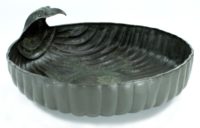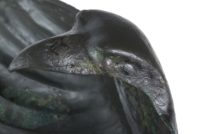 Archaeologists in Rijnsburg in the western Netherlands region of South Holland have discovered a unique eagle-headed basin from the Roman era. The site was being excavated in 2016 in advance of development of a new park when the team discovered a cremation grave from the late Roman period. Inside the grave were dozens of bronze fragments mixed in with cinerary remains of three individuals.
Archaeologists in Rijnsburg in the western Netherlands region of South Holland have discovered a unique eagle-headed basin from the Roman era. The site was being excavated in 2016 in advance of development of a new park when the team discovered a cremation grave from the late Roman period. Inside the grave were dozens of bronze fragments mixed in with cinerary remains of three individuals.
For more than a year restorers worked to puzzle the fragments back together revealing a bronze washing basin of exceptional quality. The bowl is shell-shaped, 16.5 inches in diameter with a rim four inches high. There are 33 ridges undulating across the bottom and wall. Those ridges become stylized wings where the wall transitions into the shoulders and neck of the bird of prey. The eagle’s head, its beak and eyes, are engraved in exquisite detail down to the tiny feathers on its cheeks. There are floral designs engraved on the bottom of the bowl and in a band marking the border between the wall and the wings of the eagle.
 This was not locally produced. Objects of this quality and craftsmanship were not locally produced. It was probably crafted in a specialized workshop in Italy and made its way up north with a Roman officer stationed at the nearby limes, the northern boundary of empire. Only ten such vessels have been found in Europe. This is the first one from the Netherlands, and is entirely unique in its eagle decoration.
This was not locally produced. Objects of this quality and craftsmanship were not locally produced. It was probably crafted in a specialized workshop in Italy and made its way up north with a Roman officer stationed at the nearby limes, the northern boundary of empire. Only ten such vessels have been found in Europe. This is the first one from the Netherlands, and is entirely unique in its eagle decoration.
Archaeologists believe it predates the burial. Other artifacts found in the grave, like combs made in northern Germany, indicate the deceased were likely Germanic. Their remains were buried around 330 A.D., but the basin is at least 50 years older than the other grave goods and could have been made as early as 250 A.D. It was later reused as a cinerary urn because of its great value and beauty.
[Provincial archaeologist René] Proos said the find could have been used to bribe a Germanic tribal chief: Roman generals and diplomats tried to buy the loyalty of local chiefs with gold, jewellery and bronze and silver objects.
Historians assumed the Romans left the Netherlands in the 3rd century. However, says Proos, this find, along with others from the last ten years, could mean the Roman army settled in the area again at the end of third or the beginning of the fourth century, perhaps by bribing the local chiefs.
The basin is now on display indefinitely in the Netherlands in Roman times exhibit at the Rijksmuseum van Oudheden in Leiden. It has been 3D scanned and a model created so its remarkable features can be explored in detail.
I think if you asked any birder “what bird is this?” – the response would be “Raven” – certainly as soon as I saw it that’s what I thought, and was surprised to see it described as an eagle. The shape of the brow and beak on this bowl are very typical for raven. Eagles have smoother brows, a bony orbital ridge over the eye, and a more sharply decurved beak. Ravens have a characteristic feathery ridge across the brow, often show very fine feathers extending down the bill (as seems to be the case on this bowl!) and lack the orbital ridge. The beak is straighter, with a slight decurve at the end, as on this bowl.
It’s easy to find images online that show these features.
I understand the correlation between eagle and rank, but ravens also are/were held in high esteem for wisdom and nobility.
I wonder if the archaeologists consulted an ornithologist!
How were the bronze “fragments” reassembled into this?
Whatever that bird might have been, my rather uneducated guess would be that it is a bird that a Roman or Germanic tribal chief could..
(a) eat and
(b) roast Roman style ‘al forno’.
And as the piece was found in the Netherlands, it “must” be a pheasant hen. In the even more southern region of Zeeland, i have seen them in their dozens. Moreover, I wonder if the ‘basin’ might have been copper plated.
:hattip:
———————————-
[48] ISICIA PLENA (DUMPLINGS OF PHEASANT ), according to Marcus Gavius Apicius:
[Lightly roast choice] FRESH PHEASANTS [cut them into dice and mix these with a] STIFF FORCEMEAT MADE OF THE FAT AND THE TRIMMINGS OF THE PHEASANT, SEASON WITH PEPPER, BROTH AND REDUCED WINE, SHAPE INTO CROQUETTES OR SPOON DUMPLINGS, AND POACH IN HYDROGARUM [water seasoned with garum, or even plain salt water].
…or…
[231] FOR FLAMINGO [and Parrot] IN PHŒNICOPTERO
SCALD [1] THE FLAMINGO, WASH AND DRESS IT, PUT IT IN A POT, ADD WATER, SALT, DILL, AND A LITTLE VINEGAR, TO BE PARBOILED. FINISH COOKING WITH A BUNCH OF LEEKS AND CORIANDER, AND ADD SOME REDUCED MUST TO GIVE IT COLOR. IN THE MORTAR CRUSH PEPPER, CUMIN, CORIANDER, LASER ROOT, MINT, RUE, MOISTEN WITH VINEGAR, ADD DATES, AND THE FOND OF THE BRAISED BIRD, THICKEN, [strain] COVER THE BIRD WITH THE SAUCE AND SERVE. PARROT IS PREPARED IN THE SAME MANNER.
[1] Prior to removing the feathers; also singe the fine feathers and hair.
[232] ALITER (ANOTHER WAY)
ROAST THE BIRD. CRUSH PEPPER, LOVAGE, CELERY SEED, SESAM [1] PARSLEY, MINT, SHALLOTS, DATES, HONEY, WINE, BROTH, VINEGAR, OIL, REDUCED MUST TO TASTE.
Note that the titles of these chapters and the classification is not adhered in the text of Book VI. The chapters are actually inscribed as follows:
Chap. I, Ostrich; II, Crane or Duck, Partridge, Turtle Dove, Wood Pigeon, Squab and divers birds; III, Partridge, Heathcock (Woodcock), Turtle Dove; IV, Wood Pigeon, Squab [Domestic Fattened Fowl, Flamingo]; V, Sauce for divers birds; VI, Flamingo; VII, In Order That Birds May Not Be Spoiled; VIII, Goose; IX, Chicken.
Also note that “flamingo” had to be imported :chicken:
Wrong 3d model?
Pheasants were introduced from Asia and have been naturalized as game birds through out Europe (and later America). At this early date I doubt they would have been introduced to the Low Countries..
…parts of the Black Sea are in fact Europe, and just in case it would not have been the Romans, who introduced them to Western Europe, where then should have Apicius gotten his pheasants from?
In Greece, already in the 5th century BC, φασιανάριοι -‘Phasianaroi’- where in charge of pheasants, or Φασιανὸς ὂρνις, the “bird of the river Phasis”.
330 AD is in this context, I reckon, not really “early”, and its of course always the Early bird that catches… and occasionally gets caught.
—————–
καὶ γὰρ ὀρνίθων πλῆθος ἦν αἰεὶ καὶ χηνῶν, ἔτι δὲ τῶν
νεοσσῶν ὀρνίθων, οὓς πίπους τινὲς καλοῦσι, καὶ χοίρων
καὶ τῶν περισπουδάστων φασιανικῶν ὀρνίθων.
(Athenaeus IX, 368f–369a)
Definitely not a pheasant. The depiction is clearly a Raven. The beak shape is very raven-ous and not at all of a gallinaceous bird. Though I realize that your posting may be tongue-in-beak 🙂
Ravens are native to the Italian peninsula, but not in the Netherlands (they prefer more varied terrain), which supports the idea that the object was crafted in Rome and carried north.
The black color also supports the idea that it is a Raven.
You Sir, have picked on the right spot: Definitely, at least a bit of ‘tongue-in-beak’.
I still wonder, though, if even the Romans would roast raven tongues, and why particularly all those Germanic ‘Odins’ sported the two ravens, but no ‘Jupiter’ did.
However, I have indeed not seen any of them in Zeeland ..Instead, I photographed a heron.
If only the Raven would quoth, what a story it would tell us…but alas, nevermore.